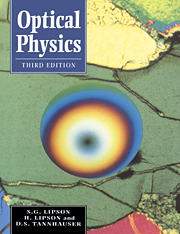Book contents
- Frontmatter
- Contents
- Preface to the third edition
- Preface to the second edition
- Preface to the first edition
- 1 History of ideas
- 2 Waves
- 3 Geometrical optics
- 4 Fourier theory
- 5 Electromagnetic waves
- 6 Polarization and anisotropic media
- 7 Diffraction
- 8 Fraunhofer diffraction and interference
- 9 Interferometry
- 10 Optical waveguides and modulated media
- 11 Coherence
- 12 Image formation
- 13 The classical theory of dispersion
- 14 Quantum optics and lasers
- 15 Problems
- Appendix 1 Bessel functions in wave optics
- Appendix 2 Lecture demonstrations in Fourier optics
- Bibliography
- Index
5 - Electromagnetic waves
- Frontmatter
- Contents
- Preface to the third edition
- Preface to the second edition
- Preface to the first edition
- 1 History of ideas
- 2 Waves
- 3 Geometrical optics
- 4 Fourier theory
- 5 Electromagnetic waves
- 6 Polarization and anisotropic media
- 7 Diffraction
- 8 Fraunhofer diffraction and interference
- 9 Interferometry
- 10 Optical waveguides and modulated media
- 11 Coherence
- 12 Image formation
- 13 The classical theory of dispersion
- 14 Quantum optics and lasers
- 15 Problems
- Appendix 1 Bessel functions in wave optics
- Appendix 2 Lecture demonstrations in Fourier optics
- Bibliography
- Index
Summary
Electromagnetism and the wave equation
This chapter will discuss the electromagnetic wave as a specific and most important example of the general treatment of wave propagation presented in Chapter 2. We shall start at the point where the elementary features of classical electricity and magnetism have been summarized in the form of Maxwell's equations, and the reader's familiarity of the steps leading to this formulation will be assumed (see, for example Grant and Phillips, 1975; Jackson, 1975). It is well-known that Maxwell's formulation included for the first time the displacement current δD/δt, the time-derivative of the ficticious displacement field D = ε0E + P, which is a combination of the applied electric field E and the electric polarization density P. This field will turn out to be of prime importance when we come to extend the treatment in this chapter to wave propagation in anisotropic media in Chapter 6.
The development presented in this chapter emphasizes the properties of simple harmonic waves in isotropic linear media, and the way in which waves behave when they meet the boundaries between media. An isotropic medium is one in which all directions in space are equivalent, and there is no difference between right-handed and left-handed rotation. An example would be a monatomic liquid; in contrast, crystals are generally anisotropic. A linear medium is one in which the polarization produced by an applied electric or magnetic field is proportional to that field.
Information
- Type
- Chapter
- Information
- Optical Physics , pp. 99 - 122Publisher: Cambridge University PressPrint publication year: 1995
